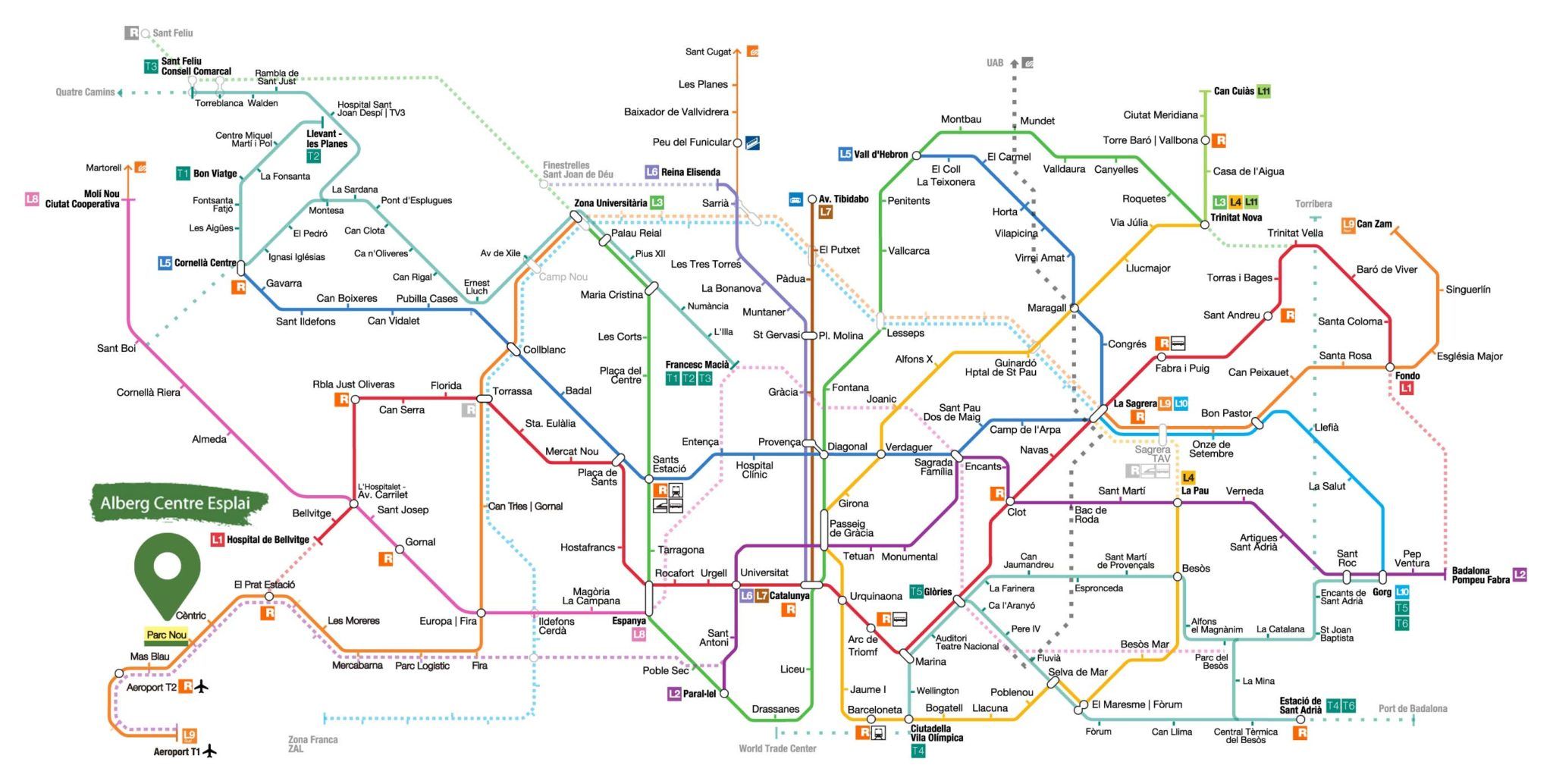
As you probably know, Barcelona has one of the most extensive metro networks in Spain, second only to the city of Madrid. This means that there are a total of 12 lines and 197 stations, making for a total of 157.8 km of railway running underneath the streets of this great city. We hope that this information will not overwhelm you, and that by using the downloadable PDF map you will have a much clearer overview of the Barcelona Metro network.
The network of lines and stations is so well-developed that navigating it is relatively easy thanks to the number of connections between them. This means that the metro network reaches other municipalities that you may also be interested in visiting: Badalona, Cornellà de Llobregat, Esplugues de Llobregat, Hospitalet de Llobregat, Montcada i Reixac, Sant Adrià del Bessòs, Sant Boi de Llobregat, Santa Coloma de Gramanet and El Prat de Llobregat, which is where Centre Esplai Hostel is located!
Línea L1: Hospital de Bellvitge - Fondo

This metro line is the second oldest of the existing Barcelona network, and it arose out of the need to unite several stations that were formerly part of the railway system. In fact, one could say that this line unites 4 different municipalities: Hospitalet de Llobregat, Barcelona, Santa Coloma de Gramanet and Badalona. The most well-known stations, and the stations where you will likely want to get off in order to visit the most emblematic sites in Barcelona, are Catalunya, Universitat and Espanya.
[icon name=”wheelchair” class=”” unprefixed_class=””] [icon name=”arrow-right” class=”” unprefixed_class=””] Out of the 30 stations found on this line, 26 of them have been adapted for people with reduced mobility and 4 have not (Plaça de Sants, Espanya, Urquinaona and Clot).
Línea L2: Paral·lel - Badalona Pompeu Fabra

This is the line represented in purple. It also joins several municipalities such as Barcelona, Sant Adrià del Besòs and Badalona. Clearly if you take this line, you will have to visit one of the most important monuments in Barcelona, designed by Antoni Gaudí: La Sagrada Familia!
[icon name=”wheelchair” class=”” unprefixed_class=””] [icon name=”arrow-right” class=”” unprefixed_class=””] Of the 18 stations found on this line, all have been adapted for people with reduced mobility.
Línea L3: Zona Universitària - Trinitat Nova

Line 4 of the Barcelona Metro supplies a fairly large area including the neighborhoods of Ciutat Vella, Eixample, Gràcia, Horta-Guinardó, Nou Barris and Sant Martí.
[icon name=”wheelchair” class=”” unprefixed_class=””] [icon name=”arrow-right” class=”” unprefixed_class=””] Out of the 22 stations found on this line, 17 have been adapted for people with reduced mobility and 5 have not (Maragall, Verdaguer, Urquinaona, Jaume I and Ciutadella-Vila Olímpica).
Línea L4: La Pau - Trinitat Nova

Line 4 of the Barcelona Metro supplies a fairly large area including the neighborhoods of Ciutat Vella, Eixample, Gràcia, Horta-Guinardó, Nou Barris and Sant Martí.
[icon name=”wheelchair” class=”” unprefixed_class=””] [icon name=”arrow-right” class=”” unprefixed_class=””] Out of the 22 stations found on this line, 17 have been adapted for people with reduced mobility and 5 have not (Maragall, Verdaguer, Urquinaona, Jaume I and Ciutadella-Vila Olímpica).
Línea L5: Cornellà Centre - Vall d'Hebron

With this line, we need to head to the opposite side of the map from what we’ve seen so far: L5 covers the municipalities of Cornellà de Llobregat, Hospitalet de Llobregat, Esplugues de Llobregat and Barcelona.
[icon name=”wheelchair” class=”” unprefixed_class=””] [icon name=”arrow-right” class=”” unprefixed_class=””] Out of the 26 stations found on this line, 23 of them have been adapted for people with reduced mobility and 3 have not (Plaça de Sants, Verdaguer and Maragall).
Línea L9 Nord: La Sagrera - Can Zam

The L9 Norte line along with L9 Sur and L10 are the newest and most automated lines of Barcelona’s railway network. To be more specific, it was inaugurated in 2009 and was the first time that the city of Barcelona had seen fully automated metro cars without operators. The L9 and L10 eventually emerged from this line.
[icon name=”wheelchair” class=”” unprefixed_class=””] [icon name=”arrow-right” class=”” unprefixed_class=””] Since it is one of the newer lines, all of the stations have been adapted for people with reduced mobility.
Línea L9 Sud: Aeroport T1 - Zona Universitària

This is our favorite Barcelona Metro line! This is the line that will bring you to Centre Esplai Hostel (Parc Nou stop) for a fantastic stay. We are fortunate to be located on one of the lines with the most facilities since the airport is so close, as well as other stations that meet up with other metro lines such as L10, L1, L5 and L3, RENFE near the Prat de Llobregat station, and the Generalitat de Catalunya railways to the Europa | Fira station.
[icon name=”wheelchair” class=”” unprefixed_class=””] [icon name=”arrow-right” class=”” unprefixed_class=””] This is one of the newer lines, like the L9 Norte, and all the stations have been adapted for people with reduced mobility.
Línea L10 Nord: La Sagrera - Gorg

As you can see, the L10 line shares features with the L9: there are two different sections, the Northern section and the Southern section. The plan is to connect and complete the lines so that they become one line. The line would then have a total of 33 stations, like the L9 which would have 39 and would become the most extensive line in Europe.
[icon name=”wheelchair” class=”” unprefixed_class=””] [icon name=”arrow-right” class=”” unprefixed_class=””] All the stations that are part of the L10 line are adapted for people with reduced mobility.
Línea L10 Sud: Foc - Collblanc

The L10 Sur metro line is made up of 5 stations located in several areas of l’Hospitalet de Llobregat. As previously mentioned, the objective in the coming years will be to join this section with the Northern section to make one line that crosses all of Barcelona, eventually arriving at the municipality of Sant Adrià del Besòs.
[icon name=”wheelchair” class=”” unprefixed_class=””] [icon name=”arrow-right” class=”” unprefixed_class=””] As part of the group of new metro lines, all stations have been adapted for people with reduced mobility.
Línea L11: Trinitat Nova - Can Cuiàs

The L11 line is one of the shortest lines in the Barcelona Metro network and was created out of the need to connect Barcelona’s Nou Barris with the municipality of Montcada y Reixac. Just like the L9 and L10, this line is fully automated.
[icon name=”wheelchair” class=”” unprefixed_class=””] [icon name=”arrow-right” class=”” unprefixed_class=””] All of the stations that are part of the L11 line have been adapted for people with reduced mobility.
Funicular de Montjuïc: Paral·lel - Parc de Montjuïc
Besides the 10 metro lines that make up Barcelona’s railway network, there is also the Montjuïc Funicular. This is a very fast means of transportation that takes you from the center of the city to Montjuïc Hill in just 2 minutes, ideal for spending an afternoon taking in the wonderful sites it has to offer.
[icon name=”wheelchair” class=”” unprefixed_class=””] [icon name=”arrow-right” class=”” unprefixed_class=””] The Montjuïc Funicular can be used by people with reduced mobility.

We can say that this means of transportion is one of the most used in Barcelona. In fact, in 2018 the passenger record was broken and more than 400 million validations were produced. That’s a lot, isn’t it? We would encourage you to join this number to make Barcelona a more sustainable province!
In addition to opting for sustainability when using this means of transportation, it can also be said that you’re saving money and time that could be used for other activities like reading, listening to music or even being social with the people around you!
Rates
This ticket can only be used for a single trip.
2.20€
This ticket can be used for a total of 10 trips and is useful if you’re going to spend a few days in Barcelona.
10.20€
The Hola BCN! ticket gives you unlimited travel on all types of public transportation (except BusNit). There are several options:
2 days[icon name=”arrow-right” class=”” unprefixed_class=””] 15.20€
3 days[icon name=”arrow-right” class=”” unprefixed_class=””] 22.20€
4 days[icon name=”arrow-right” class=”” unprefixed_class=””] 28.80€
5 days[icon name=”arrow-right” class=”” unprefixed_class=””] 35.40€
The Barcelona Card is a ticket very similar to the Hola BCN!, but it also includes discounts to several tourist attractions. The price system varies a lot more, so you can find the information here.
This ticket gives the user unlimited travel from the beginning of the day to the end of the day and is an option often used by residents.
8.60€
We know that if you come to visit Barcelona, it’s quite likely that you’ll also use other means of transportation besides the Metro, so we’ve prepared a complete guide to public transportation in Barcelona. This way you can decide which type of transportation you would like to use based on your itinerary!


